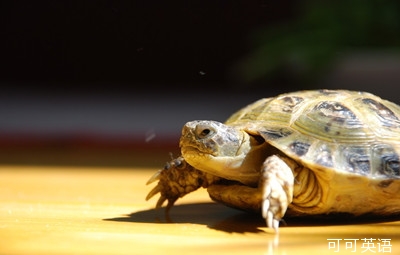科學(xué)技術(shù)
Reptilian micturition
爬行動物的排尿
That's a relief
可算是方便了
Softshell turtles urinate through their mouths
鱉類通過其嘴部小便
WHY did the turtle stick its head in a bucket?
為什么烏龜會把它的腦袋扎到桶里呢?
 sounds like the sort of riddle asked by ten-year-olds in school playgrounds.
sounds like the sort of riddle asked by ten-year-olds in school playgrounds.
這聽起來像十歲小孩子在學(xué)校操場上問的那種謎題。
But it was also asked recently by Yuen Ip of the National University of Singapore.
但是新加坡國立大學(xué)的元艾坡最近也問了這個問題。
And his answer, it has to be said, is precisely the sort that would appeal to a ten-year-old.
不得不說,他的答案恰恰是能吸引十歲小孩子的那種。
It is that turtles pee through their mouths.
答案是烏龜在用嘴巴撒尿。
The turtles in question are a species known as the Chinese softshell.
問題中的烏龜是一種被稱為中華鱉的龜種。
By preference, they live in brackish swamps.
它們偏愛生活在微咸水濕地中。
But such swamps are liable to dry up, and then the turtles often do something which has puzzled zoologists for centuries:
但是這類濕地容易干涸,然后中華鱉經(jīng)常會做出下面的動作,這讓動物學(xué)家們困惑了幾個世紀(jì):
they put their heads into those small pools of water which remain and hold them there for as long as two hours.
鱉將它們的頭部扎入余留的小水坑里,一待就是2個鐘頭。
In 1886 a pair of American biologists called Gage, who were investigating this curious behaviour, dissected several turtles and found something strange in the animals' mouths, namely a set of structures that look like gills.
1886年,兩名叫蓋奇的美國生物學(xué)家研究了這一古怪的行為。他們解剖了數(shù)只鱉,在鱉的嘴巴里發(fā)現(xiàn)了些奇異之處,即一付長得像腮的結(jié)構(gòu)。
That, they felt, explained how turtles were able to perform their head-in-a-pool trick, but not why. Softshells are not compelled to breathe through their gills; they have a perfectly adequate pair of lungs to do the job.
他們覺得這解釋了鱉為何能做出把頭扎入水坑的把戲,但無法解釋為什么要這么做。鱉類并非必須要通過腮來呼吸,用它們的兩個肺就完全足夠了。
Nor did zoologists take seriously the hypothesis that the reptiles were pining for their aquatic homes and putting their heads in puddles to keep their spirits up.
還有一個動物學(xué)家不會當(dāng)真的假設(shè):這些爬行動物離不開它們的水之家,它們將頭伸入水坑里是為了提提神。
So, with the aid of a dozen turtles purchased from a local market, Dr Ip decided he would try to solve the mystery once and for all.
所以艾坡博士從本地市場中買了十二只鱉,決定借助它們設(shè)法徹底的解開這個迷。
To do so, he strapped the animals down, to stop them moving, and provided each with a container of water into which it could dip its head if it chose.
他將這些鱉綁住,使它們無法移動,每一只前面都放了一個裝有水的容器,以便鱉可以將頭扎進(jìn)去。
He also fitted each turtle with a plastic box that collected its urine, for he had a suspicion that therein lay the key to the mystery.
他還給每只鱉配了一個塑料桶來收集它們的尿液,他懷疑解開這個謎的鑰匙就藏于其中。
This done, he monitored the animals for six days, paying particular attention to the chemistry of the water in the container.
準(zhǔn)備好后,他對這些鱉監(jiān)測了六天,并特別關(guān)注了容器中水的化學(xué)成分。
As expected, the turtles periodically submerged their heads in the water for between 20 and 100 minutes at a time.
正如所料,這些鱉定期將它們的頭扎入水中,每次的時(shí)長在20到100分鐘之間。
During these periods, Dr Ip noted that oxygen was being extracted from it.
在此期間,艾坡博士注意到水中的氧氣在被提取。
This confirmed that turtles can, indeed, breathe underwater through their mouths.
這肯定了鱉確實(shí)可以在水下通過嘴部呼吸。
As the oxygen level fell, though, something else rose: the level of urea.
可是,隨著氧含量下降,其他物質(zhì)的含量上升了-尿素。
Clearly, the animals were disposing of this waste product by secreting it from their mouths into the water.
顯然,鱉通過它們的嘴部悄悄的將這種廢物排入了水中。
Indeed, a calculation Dr Ip performed, based on the volume and composition of the urine he collected in the plastic buckets, and of the head-dunking water at the end of each day, suggested that only 6% of the urea excreted by the turtles was leaving them in the traditional manner, via urine. The question was, why?
的確如此,艾坡博士根據(jù)每天結(jié)束后其在塑料桶中所收集尿液以及頭部所扎入水的成分和體積進(jìn)行了計(jì)算,表明鱉排泄的尿素中只有6%是以尿液這一傳統(tǒng)方式排出的。問題是,為什么?
The most likely answer, as he explains in a paper in the Journal of Experimental Biology, is that urine, though cheap to produce when water is plentiful, is a physiologically costly product when water is scarce.
最可能的答案是,正如他在《實(shí)驗(yàn)生物學(xué)》上發(fā)表的論文中解釋的:雖然在水量豐沛時(shí),產(chǎn)生尿液很便宜,但當(dāng)水稀缺之時(shí),這就成了一種生理上很昂貴的產(chǎn)品了。
Turtle kidneys have difficulty processing salt water, so for an animal that lives in a brackish environment potable water is always scarce.
鱉的腎無法處理咸水,所以對于一個生活在微咸水環(huán)境中的動物來說,食水一直彌足珍貴。
One way round this for a swimming animal is to develop an outlet which allows urea to dissolve directly in the water as it swims, which is what the turtles seem to have done.
對游泳動物來講,規(guī)避此點(diǎn)的一種方式是進(jìn)化出一個可以在其游水時(shí)將尿素直接排到水中排泄器官,就像鱉類似乎已經(jīng)做到的那樣。
Dr Ip looked at which genes were active in the gill-like structures of the mouth and found one that appears, from its similarity to genes of known function from other species, to encode a urea transporter.
艾坡博士檢查了嘴部這一類腮結(jié)構(gòu)中有哪些基因在起作用,他發(fā)現(xiàn)一個基因,根據(jù)其和其他物種中已知功能基因的相似程度,會轉(zhuǎn)譯出一種尿素通道蛋白。
The turtle's gills, then, not only take in oxygen, they also excrete urea.
這樣,鱉的腮不僅能吸取氧氣,也能排出尿素。
If there is insufficient water to swim in, however, the turtles have to resort to desperate measures. The reason they stick their heads in puddles is in order to relieve themselves.
然而如果水量不足以供鱉游水時(shí),它們會采取極端手段-將頭扎入水坑是為了方便一下。
 sounds like the sort of riddle asked by ten-year-olds in school playgrounds.
sounds like the sort of riddle asked by ten-year-olds in school playgrounds.
 sounds like the sort of riddle asked by ten-year-olds in school playgrounds.
sounds like the sort of riddle asked by ten-year-olds in school playgrounds.